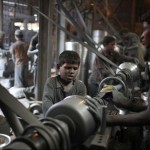
Worldwide, 215 million girls and boys remain at work.
by Guy Ryder, ILO Director-General
Child labour is a fundamental abuse of human rights. It denies girls and boys the right to be a child, to access quality education, and to hope for the future.
In its worst forms it exposes children to slavery, hazardous work and illicit activities, including drug trafficking and prostitution. While significant progress has been made in reducing the number of child labourers worldwide, 215 million girls and boys remain at work, over half of them in the worst forms of child labour.
Child labour is most difficult to tackle when it takes place behind closed doors away from the public eye. This is frequently the case with child labour in domestic work, with children sometimes working far from their families and communities.
According to new ILO estimates, two out of every three children engaged in domestic work in the home of a third party, are working below the legal minimum age or in hazardous conditions. The majority are girls and some are working as a result of forced labour and trafficking. Stories of abuse are all too common.
According to new ILO estimates, two out of every three children engaged in domestic work in the home of a third party, are working below the legal minimum age or in hazardous conditions. The majority are girls and some are working as a result of forced labour and trafficking.
In particular we urge ILO member States to ratify and ensure effective implementation of the ILO’s Conventions on child labour and on domestic work. Just two years ago the ILO adopted new standards, Convention No 189 and Recommendation No 201, which emphasize that domestic workers, like other workers, have the right to decent work. Convention No 189 also states that the minimum age for domestic workers should be consistent with the provisions of the ILO’s child labour Conventions. These require that children should not work below the legal minimum age for employment or work, and that young workers above the minimum age should be employed in safe conditions.
In addition to preventing child labour, governments should take measures to protect adolescents of legal working age employed in domestic work. This includes limiting their hours of work, prohibiting night work; restricting work that is excessively demanding, and taking measures to ensure effective protection against all forms of abuse, harassment and violence.
While on this World Day against Child Labour we focus on the problem of child labour in domestic work, we must also restate the imperative of addressing the root causes of all forms of child labour. We need to ensure that all children have access to a quality basic education and are learning, at least to the minimum age of employment.
We need national social protection floors that enable families, regardless of their circumstances, to send their children to school and to keep them there even in times of hardship. And in today’s world we need to be more focused than ever on creating decent jobs for adults across as many sectors as possible.
Our message on this World Day is clear: there is no place and no excuse for child labour in domestic or any other form of work.
Reference
World Day Against Child Labour

 The ILO is the international organization responsible for drawing up and overseeing international labour standards. It is the only 'tripartite' United Nations agency that brings together representatives of governments, employers and workers to jointly shape policies and programmes promoting Decent Work for all. This unique arrangement gives the ILO an edge in incorporating 'real world' knowledge about employment and work.
The ILO is the international organization responsible for drawing up and overseeing international labour standards. It is the only 'tripartite' United Nations agency that brings together representatives of governments, employers and workers to jointly shape policies and programmes promoting Decent Work for all. This unique arrangement gives the ILO an edge in incorporating 'real world' knowledge about employment and work.
Sorry, the comment form is closed at this time.